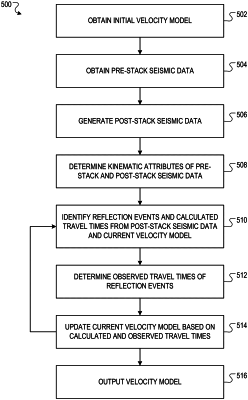| CPC G01V 1/305 (2013.01) [G01V 1/362 (2013.01); G01V 2210/514 (2013.01); G01V 2210/6222 (2013.01)] | 20 Claims |

|
1. A method implemented by one or more data processing apparatus, the method comprising:
obtaining a current velocity model for a geological region that characterizes, for each of a plurality of spatial locations in the geological region, a respective velocity of seismic waves traveling through the spatial location;
obtaining: (i) pre-stack seismic data comprising a plurality of seismic traces characterizing the geological region, and (ii) post-stack seismic data generated based on the pre- stack seismic data using a seismic stacking technique; and
for each of a plurality of iterations:
identifying a plurality of reflection events from the post-stack seismic data and the current velocity model, wherein each reflection event corresponds to: (i) a position of a seismic source that transmits a seismic wave, (ii) a local reflection surface in the geological region, and (iii) a position of a seismic receiver that receives a reflection of the seismic wave from the local reflection surface;
determining a respective observed travel time for each of the plurality of reflection events, comprising, for each reflection event:
identifying a respective seismic trace included in the pre-stack seismic data based on the reflection event; and
determining the respective observed travel time for the reflection event based at least in part on kinematic features derived from the respective seismic trace included in the pre-stack seismic data; and
updating the current velocity model based at least in part on the observed travel times of the plurality of reflection events.
|